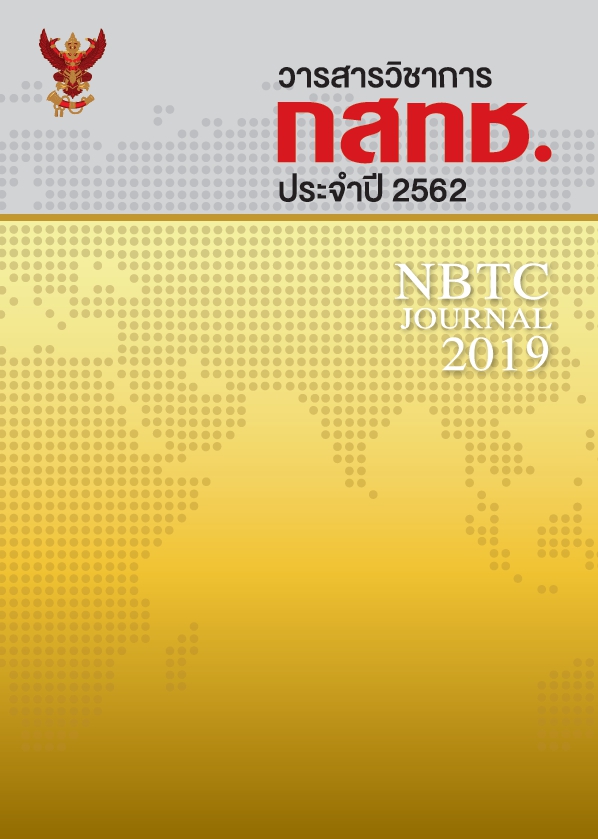ผลกระทบของการลงทุนโทรศัพท์เคลื่อนที่ระบบ 3G และ 4G ต่อพฤติกรรมของประชาชนและการพัฒนาเศรษฐกิจของประเทศไทย
คำสำคัญ:
โทรศัพท์เคลื่อนที่ความเร็วสูง, ผลกระทบทางเศรษฐกิจ, พฤติกรรมการใช้สมาร์ตโฟน, แบบจำลองดุลยภาพของโทรศัพท์เคลื่อนที่บทคัดย่อ
การศึกษานี้มีวัตถุประสงค์เพื่อประเมินผลกระทบการลงทุนระบบโทรศัพท์เคลื่อนที่ 3G/4G ซึ่งปัจจุบันได้ครอบคลุมพื้นที่ส่วนใหญ่ของประเทศว่ามีผลกระทบต่อเศรษฐกิจและสังคมอย่างไรเพื่อนำไปกำหนดนโยบายการพัฒนาในระดับถัดไป โดยการสุ่มสำรวจพฤติกรรมผู้บริโภคจำนวน 2,500 คนครอบคลุมพื้นที่ทั่วประเทศและความหลากหลายของสภาพพื้นที่และกลุ่มประชากรตามหลักวิชาการ รวมทั้งจัดทำแบบจำลองดุลยภาพทั่วไป (Computer General Equilibrium: CGE) เพื่อวิเคราะห์ผลกระทบการลงทุนระบบ 3G/4G กับ 180 สาขาเศรษฐกิจของประเทศไทย ซึ่งสาระสำคัญสรุปได้ดังนี้ 1) พฤติกรรมการใช้โทรศัพท์เคลื่อนที่ เปลี่ยนแปลงอย่างชัดเจนจากระบบเสียง (Voice) เป็นหลักสู่การเชื่อมต่ออินเตอร์เน็ต (บริการ Data) เพื่อเข้าถึงบริการที่สนใจ
ร้อยละ 82.4 ใช้ระบบ 3G/4G เป็นหลักในการใช้อินเตอร์เน็ต 2) การวิเคราะห์ CGE Matrix พบว่า ระบบ 3G/4G ไม่ก่อให้เกิดกิจกรรมทางเศรษฐกิจเชิงบวกในวงกว้าง แต่จำกัดเพียงแค่บางสาขาเท่านั้น 3) ระบบ 3G/4G ยังมีบทบาทเชิงบวกต่อเศรษฐกิจไม่มากนัก ผู้ใช้โดยทั่วไปยังอยู่ในระยะเริ่มต้นของการใช้งานส่วนบุคคล และนำมาปรับปรุงงานในองค์กร แต่การต่อยอดเป็นผลิตภัณฑ์ใหม่หรือธุรกิจใหม่ยังไม่ชัดเจน จะต้องรอเวลาจึงจะเริ่มเห็นการสร้างผลิตภัณฑ์ใหม่หรืออุตสาหกรรมใหม่โดยเฉพาะจากกลุ่ม Gen Z ที่เติบโตมาจากเทคโนโลยี 3G/4G การกระตุ้นให้เกิด Start Up จากการบริการระบบ 3G/4G ก็จะช่วยให้เกิดการสร้างมูลค่าเพิ่มให้กับเศรษฐกิจที่รวดเร็วขึ้น
เอกสารอ้างอิง
สำนักงานคณะกรรมการกำกับหลักทรัพย์และตลาดหลักทรัพย์. (2562). งบการเงินบริษัท ทรู คอร์ปอเรชั่น จำกัด (มหาชน) สืบค้น
จาก https://www.market.sec.co.th/public/idisc/th/viewmore/fs-norm?uniqueID
Reference=0000000208&searchSymbol=TRUE
สำนักงานคณะกรรมการกำกับหลักทรัพย์และตลาดหลักทรัพย์. (2562). งบการเงินบริษัท แอดวานซ์ อินโฟร์เซอร์วิส จำกัด
(มหาชน) สืบค้นจาก https://www.market.sec.co.th/public/idisc/th/viewmore/fs-norm?uniqueID
Reference=0000000807&searchSymbol=AVANC
สำนักงานคณะกรรมการกำกับหลักทรัพย์และตลาดหลักทรัพย์. (2562). งบการเงินบริษัท โทเทิ่ลแอ็คเซ็ส คอมมูนิเคชัน (มหาชน)
สืบค้นจากhttps://www.market.sec.co.th/public/idisc/th/viewmore/fs-norm?uniqueID
Reference=0000000212&searchSymbol=DTAC
สำนักงานคณะกรรมการพัฒนาเศรษฐกิจและสังคมแห่งชาติ. (2533). รายได้ประชาชาติของประเทศไทย พ.ศ.2533 สืบค้นจาก
https://www.nesdb.go.th/main.php?flename=ni_page
สำนักงานคณะกรรมการพัฒนาเศรษฐกิจและสังคมแห่งชาติ. (2533). ตารางปัจจัยการผลิตและผลผลิต (I/O Table) ประจำปี 2553
สืบค้นจาก https://www.nesdb.go.th/main.php?flename=ni_page
Bradley, T. (2014). Survey Finds Generation Gaps in Adoption of New Tech. Retrieved June 1, 2017, from
https://www.pcworld.com/article/2607111/survey-finds-generation-gaps-in-adoption-of-new-tech.html.
Carr, H., Dangerfield, P., Harris, K., Matkov, & Pettit, E. (2014). Internet and Technology Use. Retrieved June 1, 2017,
from https://www.ipsos-mori-generations.com/Internet-and-Technology-Use.
Cintakulchai, S. (1997). A Computable General Equilibrium Analysis of Trade Liberalization in Thailand. (Doctoral
Dissertation Department of Economics), University of Queensland, Australia.
Dixon, P.B., Parmenter, B.R., Powell, A.A., & P.J. Wilcoxen. (1992). Note and Problem in Applied General Equilibrium
Economics. Amsterdam: North-Holland.
Horridge, M. (2003) ORANI-G: A Generic Single Country Computable General Equilibrium Model. Centre of Policy
Studies and IMPACT Project, Monash University Press, Clayton.
O’Connor, F. (2014). Baby Boomers Embrace Technology as much as Younger Users. Retrieved June 1, 2017, from
Pagan, A. R., & Shannon, J. H. (1985). Sensitivity Analysis for Linearized Computable General Equilibrium Models.
In New Developments in Applied General Equilibrium Analysis. eds. J. Piggott and J. Whalley. New York:
Cambridge University Press.
Siksamat, S. (1998). A Multi-regional Compatible General Equilibrium Model of The Economy: A Surge in Foreign
Capital. (Doctoral Dissertation School of Economics), Monash University, Clayton.
Taylor, L. & Rosenweig, J.A. (1984). Devaluation, Capital Flow and Crowding-Out: A CGE Model with Portfolio
Choice for Thailand Economics Development, M.I.T Press, Boston.
Teal, F. (1990). General Equilibrium Model: Australia’s Term of Trade and the Real Exchange Rate” Discussion
Paper No.235. Center of Economic Policy Research Australia.
Warr, P.G., Jieamanugulgit, P., Lapiz, E.A., & Sarntisart, I. (1994). Estimation of Parameter for PARA Model in The
PARA General Equilibrium Model of The Thai Economy. Office of Agricultural and Australian National University.
Wongwatansin, U. (1999). General Equilibrim Valuation of Industial Policy on Output, Trade Flows, and Income
Distribution in Thailand. (Unpublished Doctoral Dissertation School of Economics), The University of North
Carolina, Chapel Hill.
ดาวน์โหลด
เผยแพร่แล้ว
รูปแบบการอ้างอิง
ฉบับ
ประเภทบทความ
สัญญาอนุญาต
บทความที่ปรากฏในวารสารกิจการสื่อสารดิจิทัล เป็นลิขสิทธิ์ของสำนักงาน กสทช. ซึ่งสำนักงาน กสทช. เปิดโอกาสให้สาธารณะหรือบุคคลทั่วไปสามารถนำผลงานไปเผยแพร่ คัดลอก หรือตีพิมพ์ซ้ำได้ ภายใต้สัญญาอนุญาตแบบเปิด (Creative Commons: CC) โดยมีเงื่อนไขสำหรับผู้ที่นำผลงานไปใช้ต้องระบุอ้างอิงแหล่งที่มา (Attribution: BY) ห้ามดัดแปลง (NoDerivatives: ND) และต้องไม่ใช้เพื่อการค้า (NonCommercial: NC) เว้นแต่ได้รับอนุญาตเป็นลายลักษณ์อักษรจากสำนักงาน กสทช.
อนึ่ง ข้อความ ตาราง และภาพที่ปรากฏในบทความซึ่งได้รับการตอบรับให้ตีพิมพ์และเผยแพร่ในวารสารนี้เป็นความคิดเห็นของผู้นิพนธ์ โดยไม่ผูกพันต่อ กสทช. และสำนักงาน กสทช. หากมีความผิดพลาดใด ๆ ผู้นิพนธ์แต่ละท่านต้องรับผิดชอบบทความของตนเองแต่เพียงผู้เดียว ไม่เกี่ยวข้องกับ กสทช. และสำนักงาน กสทช. แต่ประการใด



